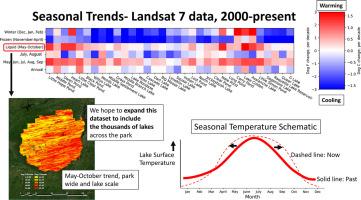阿迪朗达克湖卫星地表水温度观测的验证和趋势分析
Q2 Environmental Science
引用次数: 0
摘要
本研究旨在验证和评估来自位于纽约州北部阿迪朗达克州立公园135个湖泊的Landsat系列卫星遥感观测结果,并检查过去40年来这些湖泊的表面温度趋势。它利用了中分辨率成像光谱仪(MODIS)以及陆地卫星5号和7号的数据。公园尺度的结果是通过提取公园边界内的MODIS表面温度得到的,而湖泊尺度的结果是使用Landsat 5(1984-2012)和Landsat 7(1999-2023)观测数据估计的。此外,利用野外观测对卫星地表温度数据进行了全面的验证和评估。研究结果表明,卫星获取的温度在原位测量的合理范围内,均方根误差为1.97 ~ 2.08℃,相关系数为0.64 ~ 0.75。年和月综合趋势分析显示,与Landsat 7期相比,Landsat 5期的温度值表现出更高的升温速率,后者表现出季节变化,甚至出现了一些降温月份。每月modis得出的公园范围的趋势范围为- 1.57°C至1.2°C(3月至11月),其幅度通常低于从Landsat数据估计的幅度。平均而言,阿迪朗达克湖的湖泊显示出每十年约0.89°C的变暖趋势。季节分析显示,夏季的变暖速度在5月和10月/ 9月加快。这些发现强调了卫星观测在监测气候变化对湖泊生态系统的影响方面的关键作用,特别是在地面数据有限的地区。本文章由计算机程序翻译,如有差异,请以英文原文为准。

Validation and trend analysis of satellite-derived surface water temperature observations over adirondack lakes
This study aims to validate and evaluate satellite remote sensing observations from the Landsat series over 135 lakes in the Adirondack State Park, located in upstate New York, and to examine their surface temperature trends over the past 40 years. It utilizes data from the Moderate Resolution Imaging Spectroradiometer (MODIS), along with Landsat 5 and 7. Park-scale results were derived by extracting MODIS surface temperatures within the park boundary, while lake-scale results were estimated using Landsat 5 (1984-2012) and Landsat 7 (1999-2023) observations. In addition, field observations were utilized to perform a comprehensive validation and evaluation of satellite-based surface temperature data. The findings indicate that satellite-derived temperatures are within a reasonable range of in situ measurements, with RMSEs ranging from 1.97 to 2.08°C and correlation coefficients between 0.64 and 0.75. Comprehensive trend analyses conducted on an annual and monthly basis reveal that temperature values during the Landsat 5 period exhibited higher warming rates compared to the Landsat 7 period, which showed seasonal variations and even some cooling months. Monthly MODIS-derived park-wide trends ranged from −1.57 °C to 1.2 °C (March to November) and were generally lower in magnitude than those estimated from Landsat data. On average, lakes in the Adirondack lakes demonstrated a warming trend of about 0.89°C per decade. The seasonal analyses revealed an expansion of the summer season, with higher warming rates in May and October/September. These findings highlight the critical role of satellite observations in monitoring climate change impacts on lake ecosystems, especially in regions with limited ground-based data.
求助全文
通过发布文献求助,成功后即可免费获取论文全文。
去求助
来源期刊

Environmental Advances
Environmental Science-Environmental Science (miscellaneous)
CiteScore
7.30
自引率
0.00%
发文量
165
审稿时长
12 weeks
期刊介绍:
 求助内容:
求助内容: 应助结果提醒方式:
应助结果提醒方式:


